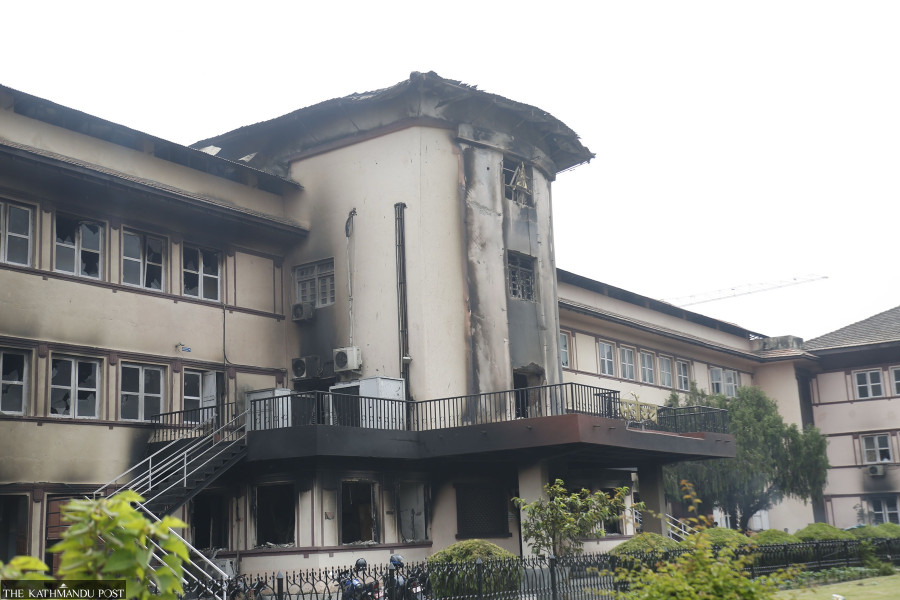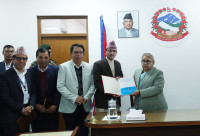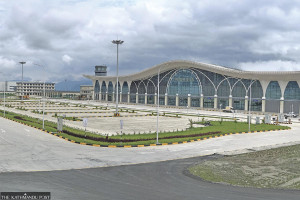National
Supreme Court may take months to resume full-fledged operation
The court has listed out five ways to recover the destroyed case files.
Binod Ghimire
Over a month after the Supreme Court building was destroyed in the Gen Z-led movement, it is still unclear when the country’s top court will return to full-fledged operation.
A week after the arson in its complex, the court started hearing habeas corpus petitions on September 14 from a makeshift structure on its premises. However, as most of the case files and the offices were burnt down, the top court is unable to conduct other hearings.
“We are very much willing to resume hearings,” said Man Bahadur Karki, registrar at the court. “But it is impossible without the place to house the benches and working space for staff.”
The Gen Z protest that began on September 8 turned violent after 19 youths—17 outside the federal parliament at New Baneshwar, and two in Itahari—were killed in police firing on the same day.
The next day, protesters not only torched the houses of then-prime minister KP Sharma Oli and several other leaders, but also attacked public properties.
According to the assessment of the Department of Urban Development and Building Construction, as many as 440 buildings of 287 federal offices, including the Supreme Court and its subordinate courts, were torched during violent protests.
Fires destroyed buildings, other infrastructure, important documents, and case files. Karki said 20,000 of the 24,200 files of the running cases were destroyed in the fires. Hundreds of files of the already decided cases have also turned into ashes. The top court was established in 1956.
Holding a meeting with the Nepal Bar Association and the Attorney General’s Office on Thursday, Chief Justice Prakash Man Singh Raut had said he was concerned about the delay in justice delivery. He had claimed that the court’s information technology section is currently working to recover the data. “The court will resume its full services once the data is recovered.”
Court officials say they plan to start hearing from a few benches after Tihar in the last week of October.
“We can make ambitious claims but I do not see the possibility of a full-fledged hearing to commence in the next five to six months,” said a senior official at the court.
As conducting a hearing is not possible without case files in place, the court’s full bench on September 21 had decided to prepare a directive to recover destroyed case files. Accordingly, the Supreme Court has issued the Directive on the Recovery and Authentication of Case Files Destroyed Due to Special Circumstances, listing out five ways to recover the destroyed case files.
First, it will collect copies of documents or records related to cases available with any court or institution. Second, it will gather judgments and documents uploaded on the websites of the Supreme Court and other government bodies.
Third, the court will collect documents that are in possession of judges and staff obtained during court proceedings. Fourth, it will gather documents exchanged electronically between various courts, other government bodies, and judges or court officials. Finally, the fifth method allows for the collection of documents through other “appropriate means”.
“Producing 20,000 case files is not a joke,” Karki said. “It will take months.”
At Thursday’s meeting, the Nepal Bar Association assured support to recovering the case files and coordinating with the lawyers of the cases concerned. Karki said, along with recovering the case files, a detailed assessment of the infrastructure, material, documentary and archival damage is ongoing.
Along with the Supreme Court, 23 lower courts were attacked by the protesters on September 9. The Kathmandu District Court, the Special Court, Tulsipur High Court, Biratnagar High Court, and Tanahu District Court suffered huge damage. The Kathmandu District Court alone lost at least half a million files of sub judice and decided cases.




 16.12°C Kathmandu
16.12°C Kathmandu














